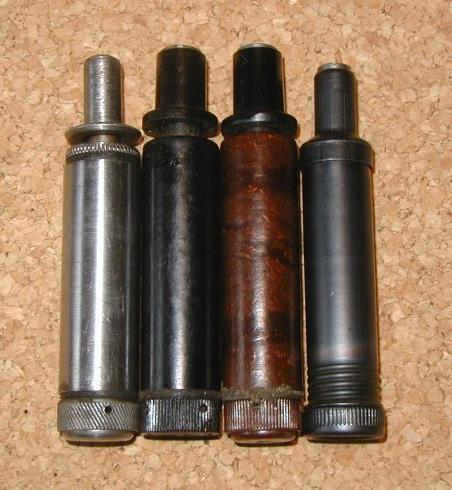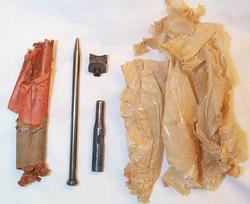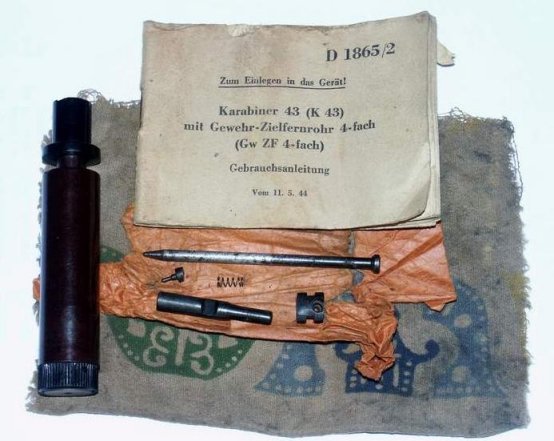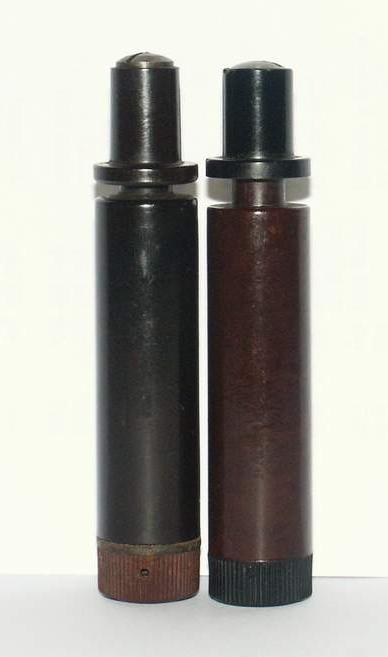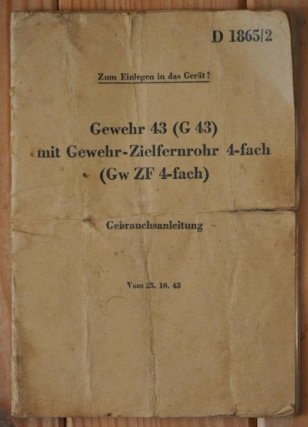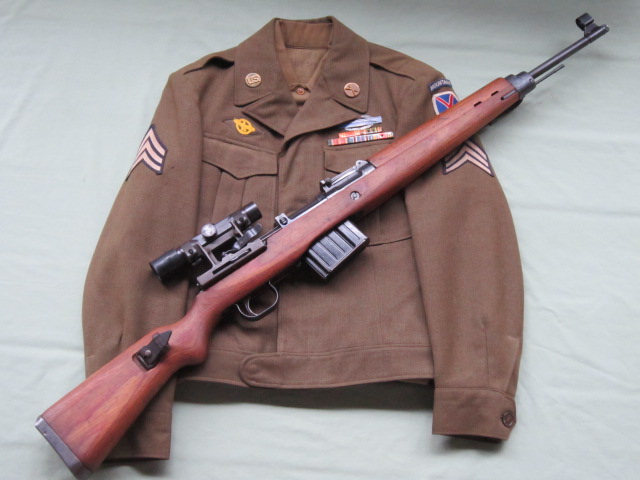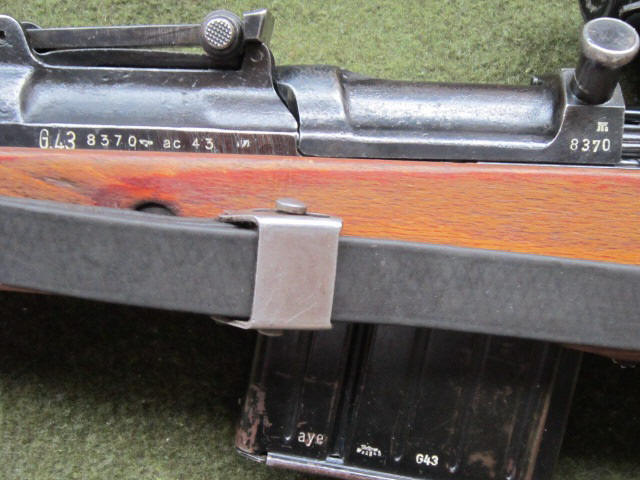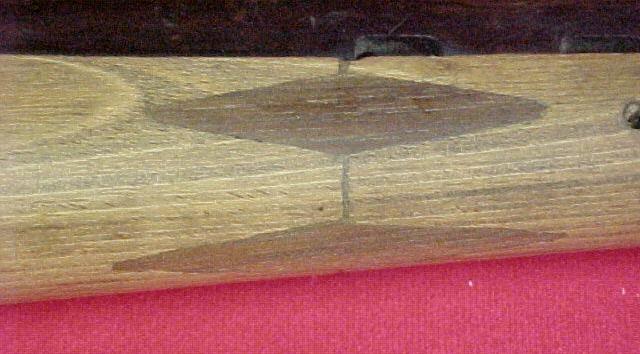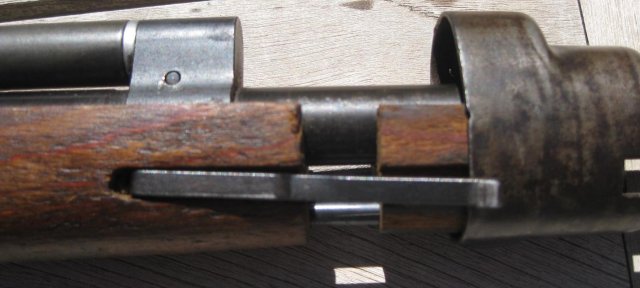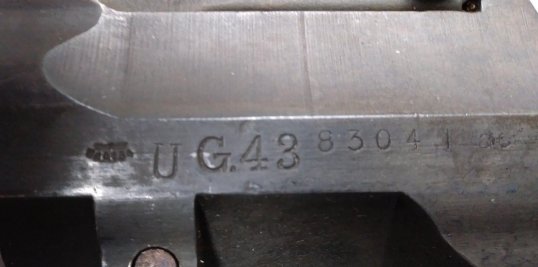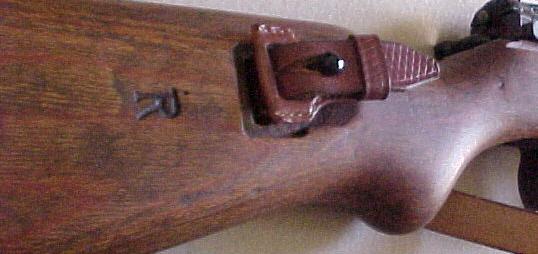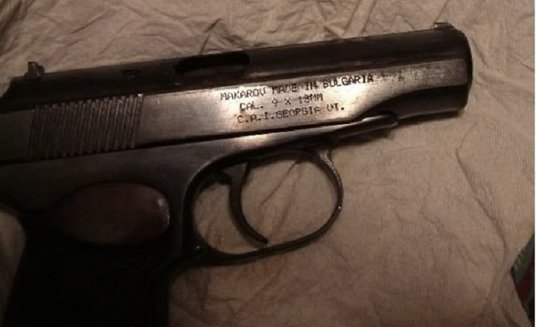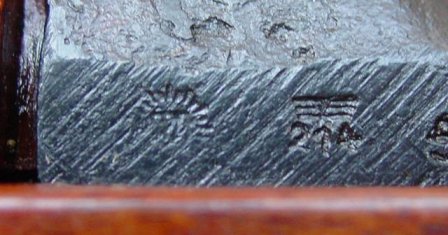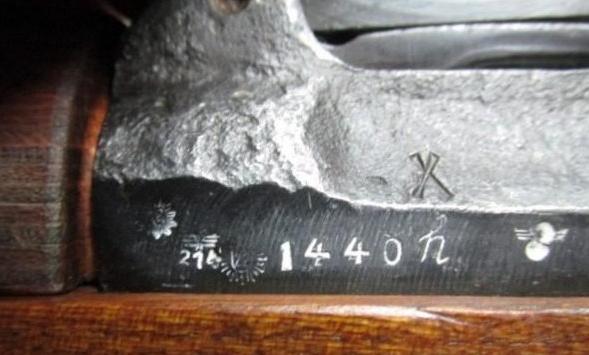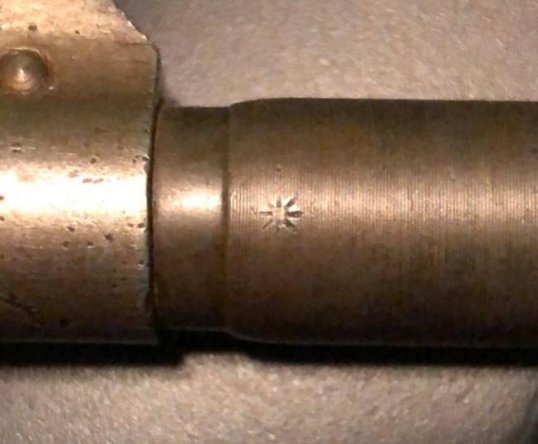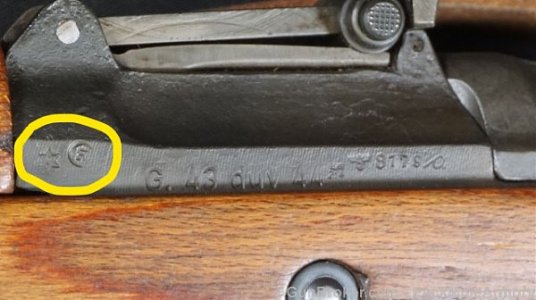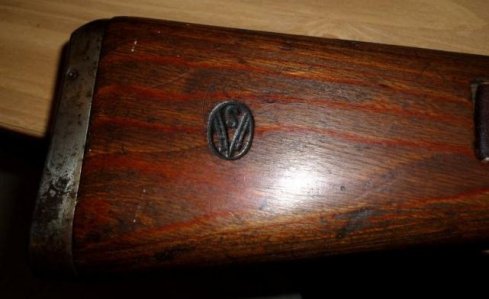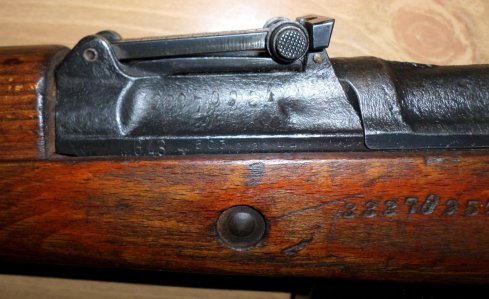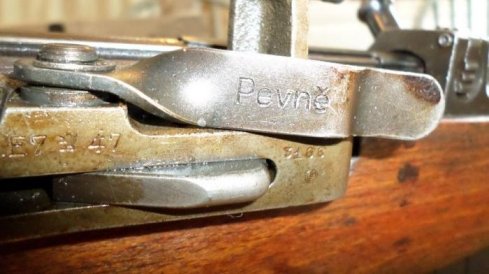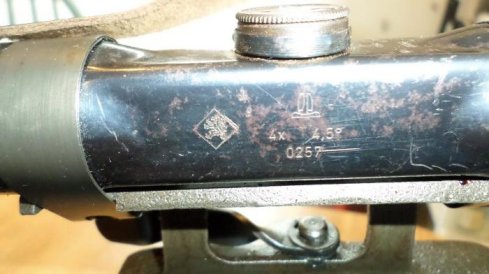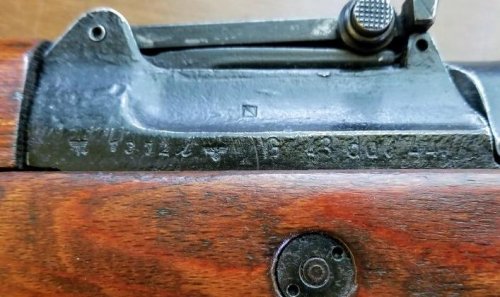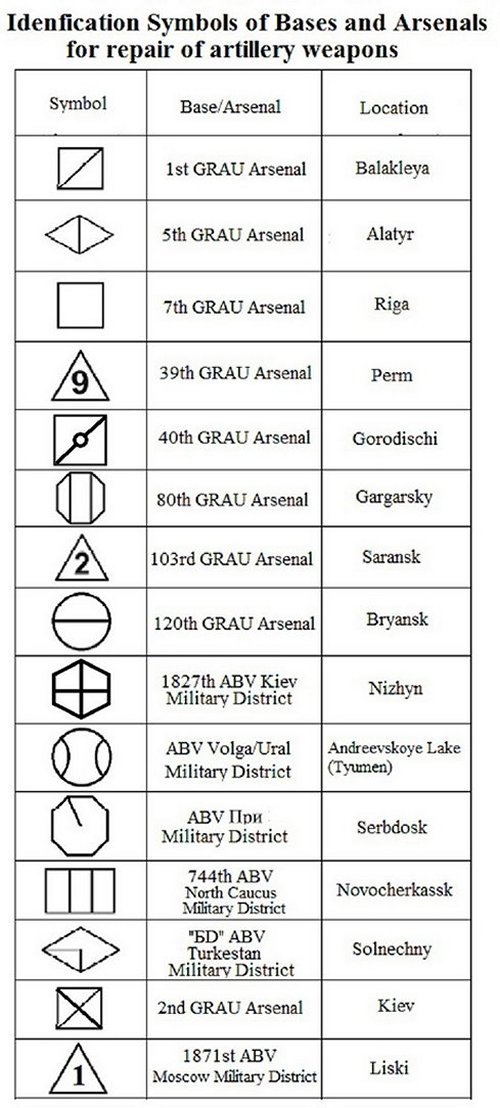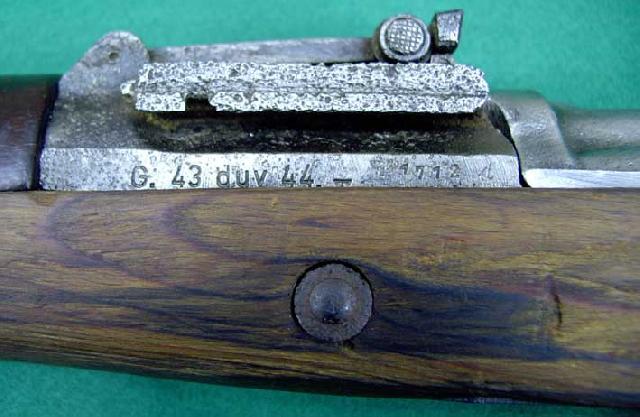
G43 in General - G41 & G43 Parts
A General description of G43 / K43
Specifications: Weight: 4.1 kg (9.0 lb) unloaded with magazine and no scope, 4.4 kg (9.7 lb) loaded, Length: 1120 mm (44.1"), Barrel length: 550 mm (21.6"), Cartridge: 7.92x57JS, Action: gas-operated, 2 locking lugs operated by the firing pin housing - semi auto, Velocity: 746 m/s - sS-ammo (2448 ft/s), Feed system: 10 rounds detachable magazine, evt. with fixed magazine and stripper-clips, Sights: rear adjustable sight, V-notch up to 1200m, front: hooded post.
About 415,000 were produced. Of these were about 57,000 delivered from the factory with the ZF4 scope.

It seems as this stock here has got a thin layer of lacquer. It is perhaps a post-war "improvement" - most stocks were just left untouched. The buttplates exist in two types: early, with ribbed door - and later with flat door.
The rifle was made with following codes: 1) "ac": Carl Walther, Zella-Mehlis in 1943, 44 and 45, 2) "bcd": Gustloff Werke, Weimar in 1944, 3) "duv" and "qve": Berliner-Luebecker Maschinenfabrik, Luebeck in 1944 and 45. The designation was changed from "Gewehr" to "Karabiner" from about Nov.- Dec. 1944. B-L M produced only K43 in 1945, but Walther produced up to the end of the war still some G43. Gustloff made only G43.
| Walther | Gustloff | B-L M | Total year | |
| 1943: | 3,210 | 0 | 0 | 3,210 | 1944: | 173,320 | 35,200 | 99,880 | 308,400 |
| 1945*): | 47,270 | 0 | 56,120 | 103,390 |
| Total | 223,800 | 35,200 | 156,000 | 415,000 |
When was your G43 / K43 made?
Click on the table below: See a database of more than 4000 observations of the G43 / K43 here.
Common misunderstandings and claims:
The US Garand - Carbine - Enfield - MP40 etc. were well-known right from the beginning, but the G43 "came out of the darkness" - produceded in Germany during the last two years of the war. There was no big charisma about German weapons many years after the war, so the statements were perhaps more or less accidental based on few weapons or remarks from soldiers. What was written once were often perpetuated for years in book after book - and today repeated on websites and forums.
The K43 was shorter than the G43 and lacked the holdopen latch:
The change from the name G43 to K43 was decided on April 25, 1944. It's was only a name-change nothing more; all these rifles have the same barrel length = 550 mm. Most will regard a "Karabiner" (carbine) as a shorter gun than a "Gewehr" (rifle), but as said in this case it was only a matter of designation. It's correct that many of the last produced K43 didn't have the bolt holdopen latch, and this was only effective for the Walther production.
The G43 was made by Mauser
No - this was a common claim some years after the war - when the best known German gun factory was Mauser. As far as we know Mauser did not even made small parts for the G43.
All G43 had a scope mounting to be used for the 1 1/2 power ZF41 scope
This can be read in Smith / Smith: Small Arms of the World and on the net. No, the scope was the 4-power ZF4 scope, and most G43 had a rail for mounting (but no mount) of this scope.
The "qve" code represents Walther, Zella-Mehlis
Another misinformation that has been repeated for years. The "qve" code isn't mentioned in the original German code book, but there are many good arguments for the code belonged to B-L M - it can be proven 100%.
They used plastic stocks
- with a loaded weight of 3.6 kg. Walther experimented with plastic stocks in the last few months, but less than 5 are known to have survived the war, so this claim is untrue. Another thing is that B-L M used "Durofol" handguards - a kind of artificial material.
Cast receivers and bolt carriers were used as a production short cut
No, all receivers and bolt carriers were forged. I have seen a K43 fired without the locking lugs. Well, there are two recoil springs, but they take perhaps 1% of the recoil, so the bolt housing and the receiver had to take the 99% of the recoil with a bang. The result was a somewhat bent receiver, a bulge in the bolt housing and a cracked stock. The careless shooter was uninjured, but I presume he will THINK before he next time pulls the trigger. The conclusion is that the forged receiver - also the last made - was very strong.
The quality of production was rather haphazard during the last years of the war
Yes, the G43 was built only during the last 1 1/2 year of the war. And the parts were only machined where necessary, but there is no indication of that the soldiers didn't dare to shoot the gun. The parts were machined with the correct fitting and it's always better (to day) to use original parts produced under awful conditions than use modern repros. Even the Nazis cared about their own soldiers and there are no reports indicating specific dangerous problems with the gun. I think this allegation comes from the fact that all soldiers believe that their weapons are the best, and when they saw an ememy weapon looking like trash - it was trash! However when this is said it's a really good idea if you have a competent gunsmith to inspect the G43 prior shooting it.
The G43 in the "Weapons Hall of Fame"?
No - not really:
Innovation
The idea behind the bolt locking system was taken from the Soviet Degtyarev DP27 light machine gun, so not much new here. The same can be said about the gas system: It was taken from the Soviet SVT38/40 selfloading rifle. This rifle had a gas-regulator screw, but the Germans thought this was a complication and constructed the gas-system on full power which is almost too much when shooting in good circumstances.
But I think the production of the action cover / bolt housing is an innovation. It was no easy task to start with a flat piece of sheet steel and press it several times to a tubular shape and then add the end. This had to be done very accurately, so the bolt carrier fits outside and the bolt fits inside. The same can be said about the milled action cover / bolt housing. Here they started with a solid piece of steel and milled it outside and inside. I time consuming job hardly done by anybody.
B-L M did some innovations in barrel making. The barrels were hammer-forged and they used a barrel straightening machine, so they didn't have to rely on well-trained craftsmen using personal judgement. The barrels were not threaded but pressed into the receiver and then secured with a pin. These inventions interested the American army after the war. B-L M made more than a million quality weapons up to the end of the war, but closed then as a weapon factory.
Some of the G43's (about 14%) were delivered with an optical sight (ZF4). The scope rail was a part of the receiver - a much more stable system than for example the scope mounting on a MP44 or a FN FAL, where the mount is fitted to the sheet metal covering the receiver. The scope was fitted to the mount with tempered steel bands. A cheap way to do it - later used by the FAL. I have never heard complaints about the method, but I have experienced the scope moved forward by shooting, so I had to abandon further shooting. This usually happened after 15 shots - just about the time when I thought: next time it's the bull's-eye.
Reliability
No top points scored here either. Many of the moving parts were exposed to dirt and sand. Another point was the extractor. I have never lost an extractor during shooting, but it's very difficult to exchange with the tiny spring and screw - and impossible to exchange in bad weather with frozen fingers. The fitting of the safety lever was very simple made - and not up to the standards for German weapon production. The dustcover was also of an awkward design. The first - automatic - didn't work, and the last - manual - blocked for the safety lever. The gas-system was proned to fouling because the use of corrosive ammunition. I presume it wasn't a vital failure if the gun was regularly used or maintained.
Accuracy
The accuracy of the G43 with iron sights was in the same category as the US Garand and the Soviet SVT40. It's here worth to mention that much of the ammunition made after 1943 was bad. In order not to use so much lead they used bullets with an iron core - of the type SmE. This were lighter than the sS type, but the initial velocity was higher. Some of this ammo was not to be used in MG, because it could give jamming. It must be presumed that the soldiers tried to get the "good" sS ammuntion made before 1943, if this was possible.
The intention was to use the K43 ZF4 for sharpshooting / sniping, but it could't match the K98k with commercial ZF. Right from the first production to the very last tests in March, 1945 the massproduced K43 ZF4 was a failure. The main reason was the ZF4. It performed very well when scrupulously made and inspected, but with a demand from above on 25,000 produced each month made this impossible. The rather thin and perhaps not so carefully made barrel was another explanation. Reports from that time say that simply removing and sliding the mount back on influenced very much on the shotgroups. The K43 ZF4 was no sniperrifle - it was a rifle with an optical sight as we see today with many army standard rifles. The Germans should have dropped the K43 ZF4 - and used the resources elsewhere, but there was too much prestige behind the idea, incl. orders from "der Fuehrer", so this wasn't possible.
Combat effectiveness
This is of course a crucial point for a weapon. It seems as the G43 was an effective weapon within normal combat distance - that means 300 m. The few combat reports we have tell us that the combination of the semi-automatic mechanism plus the ten-round magazine were evident advantages. This enabled the shooter to switch rapidly between targets without operating the bolt. Ten aimed shots were fired much faster than with a K98k. Seen from the shooters point of view the K43 was more comfortable to shoot than the K98k. It was as some of the recoil disappears with semi-automatic function. A shooter who has fired 50 shots with a K98k is really "tired" in his shoulder.
Service length
About 415,000 were made and a production period of a little more than 1 1/2 year gives only a limited score.
Original footage showing G/K43 in use: Battlefield S2/E4 - The battle for Italy - 51m56s
See interesting user related videos here. (close to the bottom on the page)
G43 versus Garand
First some comments about the Tokarev SVT40: The Soviet Union had by the late 1941 produced 1 1/4 million SVT38/40. 467,700 Garands were made in USA and in Germany Mauser and Walther had only made 6,673 G41. 55,910 (incl. 1942) were the scoped version of the SVT. The SVT40 was a competent sniper rifle with a good scope, but it was plagued by problems with vertical "flyers". The problems were so severe that the production of the sniper version was terminated in 1942 and they returned to the old Mosin-Nagant rifle and used this as sniper rifle. The first months of the war were disastrous for the Soviet Union, and hundreds of thousands of SVT40s were lost. To make up for this, production of the Mosin Nagant rifles was reintroduced. In contrast, the SVT was more difficult to manufacture, and troops with only rudimentary training had difficulty maintaining it. In addition, submachine guns like the PPSh41 had proven their value as simple, cheap, and effective weapons to supplement infantry firepower. This led to a gradual decline in the SVT production and the last SVT40 was produced on Jan. 3, 1945.
Some say that - if the G43 quality issues have been resolved - then it could have matched the Garand. They made an attempt in Brazil - or a copy in cal. 30-06. This was no success. In my opinion the G43 was a fundamentally wrong design. The safety lever could have been re-constructed, but the remaining problem - the much vulnerable extractor couldn't be changed without making a new bolt construction - see further below. However the rifle had two advantages compared to the Garand: The detachable 10 round box-magazine and the scope rail on the right-rear of the receiver, which allowed for central fitting of the scope. The SVT40 had also a detachable 10 round box magazine and scope rail, but had some other weaknesses such as a flimsy stock and a safety that only blocked the trigger.
| G43 | Garand | SVT40 | |
| Caliber | 8x57JS | 30-06 | 7.62x54R | Bullet weight, gram | 12.80 | 9.85 | 11.98 |
| Length, mm | 1117 | 1107 | 1222 |
| Empty weight, kg | 4.1 | 4.3 | 3.9 |
| Barrel length, mm | 550 | 610 | 625 |
| Magazine | 10 rd. box | 8 rd. clip | 10 rd. box |
| Muzzle vel. m/sec. | 746 | 855 | 765 |
| Energy 0m, joule | 3562 | 3600 | 3505 |
| Energy 300m, joule | 2370 | 1861 | 1968? |
Back to the U.S.S.R: As told above the SVT40 production was dropped before the war ended. Two years later came the automatic assault rifle AK47 - the same concept as the StG44, using the intermediate round 7.62x39, had pistolgrip and 30 round magazine. The Russian conclusion was obviously: a fully automatic assault rifle cannot use a full power rifle cartridge. This was the same conclusion as the Americans came up with more than 20 years later with the M14 versus the M16. In my opinion, the ammunition should apply to each weapon type. Different requirements - different solutions. 9 mm Para = pistols (MP for police-use), intermediate ammo = assault rifles, full size ammo = MG's and .338 Lapua e.g. = sniper rifles. So many of the "nice" semi (full) automatic rifles we know of, such as the M14, FN FAL, G3 weren't really "war-machines". They could be good enough if the other side used bolt action rifles, but they were no match if the opponent used AK47. I think the history proves that.
Mauser Geraet 03 (Model 03)
Mauser did not produce parts for the G43, but they "had a finger in the pie" with this G43 with Mauser roller lock and a much more reliable extractor (like the G3). Note also the improved safety. The rifle was tested officially in the summer of 1944. 4 were made and 3 have survived. One must presume that this was a better construction than the ordinary G43 - but not cheaper to make. The Germans had at that time decided to concentrate about the MP44 and kurz ammo. The MP44 was cheaper too: 66 Reichmarks (in 1945 the price was quoted to 40 RM) compared to 150 Reichmarks for a G43. (a Tiger I tank cost 250.800 Reichmarks + equipment)
You can see a video description of this rare gun here

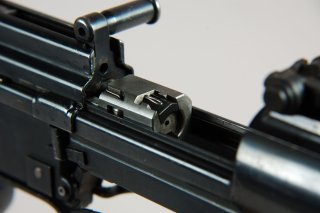
The last K43 "f" block
It appears that Walther wasn't able to assemble the K43 very late in the war. B-L M placed the "ac" receivers (and probably other parts too - such as the barrel?) into the existing production line. Darrin Weaver gives a possible explanation of this: The Walther's main factory in Zella-Mehlis had fallen to the Americans on April 4 - or the roads were blocked even before. However Walther-Werke II in KZ Neuengamme near Hamburg continued production some days more, and some of their parts were transported to the B-L M works in Luebeck about 65 km eastward. B-L M ceased first the production on May 2. A small notice about this subject here.
See below such an example. The receiver is marked: WaA214 5326f K43 ac 45 It looks as the right side of the receiver has been welded up and then re-machined. This receiver was originally a dual guide lug example and it has had the right lug machined off, since Berlin Lubecker did not have (maybe not received any from Walther?) correct bolts to complete this type of receiver. The stock, while it does have the "WaA214" proofs on the right side of the stock, is a typical forward recoil lug type used exclusively by Walter....obviously came over with the receivers.
See further below a K43 with a normally B-L M produced receiver - marked WaA214 8971f K. 43 qve 45 The next-highest number recorded until now. Note the original content in the butt-stock.
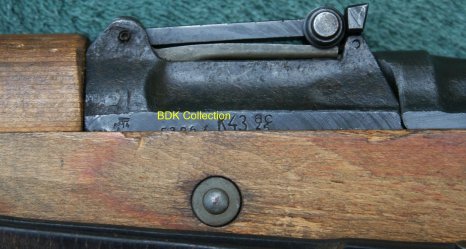
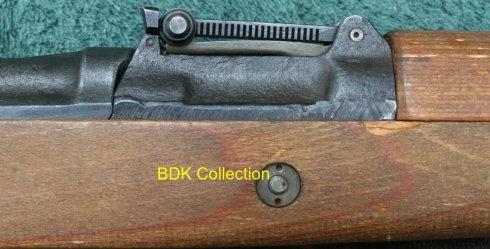
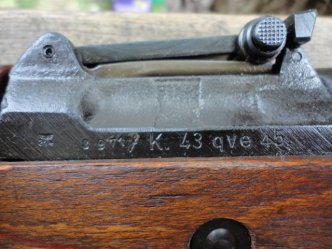
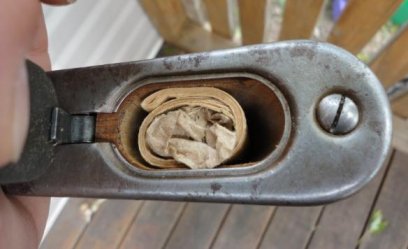
Differences between the G41 and G43 bolt parts
The carriers are different - it's easily seen.
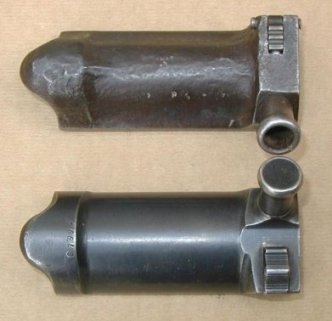
The bolt housings are different too (here compared to the rather rare milled G/K43 type). The G41 type is about 1.5 mm shorter and 0.10 mm wider. The front parts are different and note also that the cut-outs at the rear part are different.
Some claim B-L M used previously rejected G41 bolt housings in their G43 production. This isn't true. They must have had problems with the delivery of the stamped steel housing, and that's why they made their own milled bolt housing. The G43 milled housing appears on Jan. 1945 and very late B-L M production - plus on B-L M duv 44 in the "c" and "d" blocks.
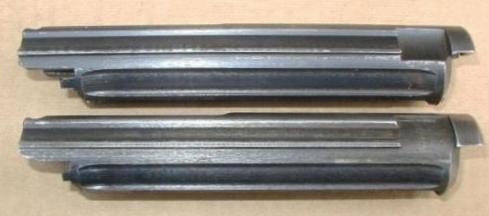
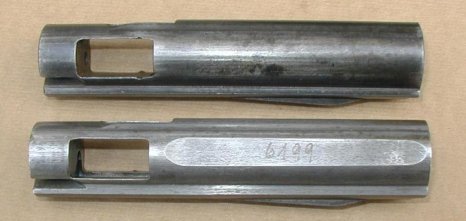
The milled bolt housing is also seen on the very first (from 1943) Walther G43's.
Upper: G43, lower: G41. Notice that the G41 bolt has flat sides while the length is the same.
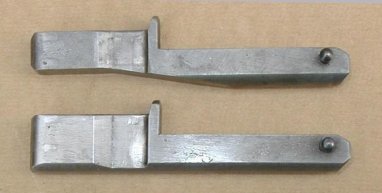
The G41 firing pin housing is much higher. The locking lugs and the firing pin are the same.
|
Receiver parts |
As seen below only some pins and washers are the same in the two models. The ejector appears to be the same (not seen on the picture).
G43 bolt housings |
|
Upper: Is milled like the G41W -
see description above Middle: Is used normally. It's made of stamped steel and has WaAA44 (Merz Werke, Frankfurt a.M.). Lower: It's like the stamped steel type but has no notch for the bolt hold open lever. Used on some late K43ac45. See the page about the ac45 dual guide rib type. 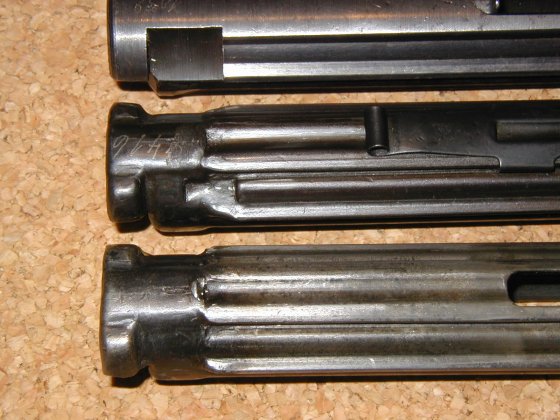
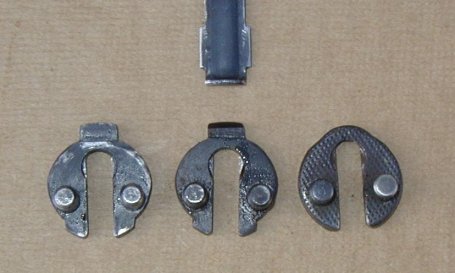 |
| Narrow dustcover |
|
There are 4 types of dustcover: 1. Narrow (seen here) used with the milled G41 housing. 2. Automatic closing cover with a little projection. 2a. Manual - shortened type 2. 3. Manual - long (it interferes with the safety lever). See picture above with stamped steel housing. |

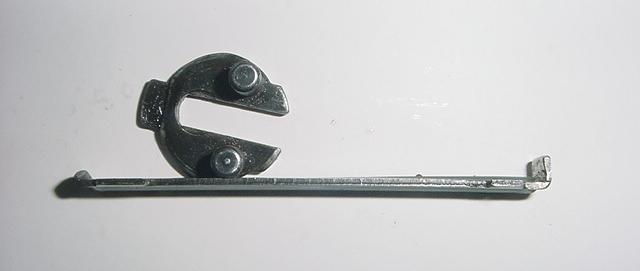
Recoil spring guides
From left to right:
G41, G43 cut at an angle, common G43
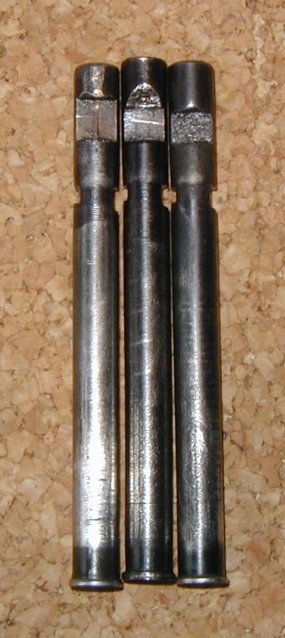
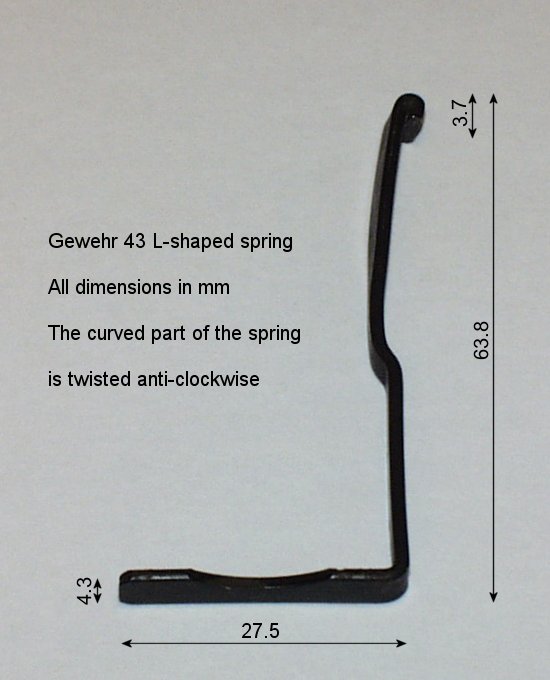
L-spring for the front band - above right
| Cross lug |
|
Dimensions (in mm): Rectangular part: 38.4 x 9.9 x 6.0 thread: 6.0 x 1.0 - 5.5 long Disks: diam. 13.0, 3.0 thick Knob on left disk: 1.4 high, 7.5 in diam. Right disk. 2 x 2,0 holes, depth: 1.7, dist.: 10.8 |

| Trigger guard pin |
|
(the little pin which prevents
the triggerguard screw from moving) Dimensions (in mm): Length: 8.60, diameter: 3.45. The left end turns towards the triggerguard screw - note that this pin just isn't a piece of wire. Keep the pin in place by pressing the pin back in it's hole and restruck the peen with a prick punch. 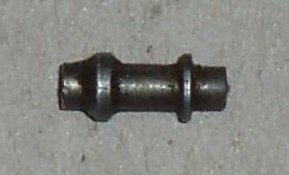
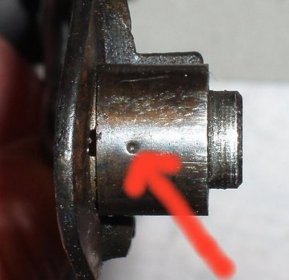
|
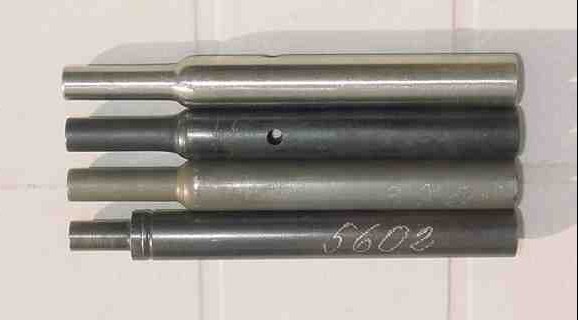
| Front sight bases |
Left: barreled thread 14.0
mm diameter. Middle: No thread 14.0 mm diameter. Right: 15.5 mm
diameter. There is a fourth variation: 14.0 mm diameter with
non ribbed ramp. Plus a fifth variation 15.5 with ribbed ramp.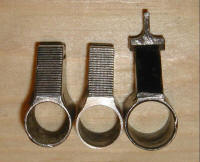
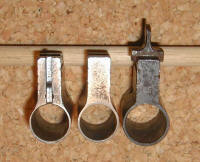 Click to enlarge either image
Click to enlarge either imageHandguards Top to bottom: Original laminated wood Original Durofol Original synthetic VOPO Reproduction Durofol 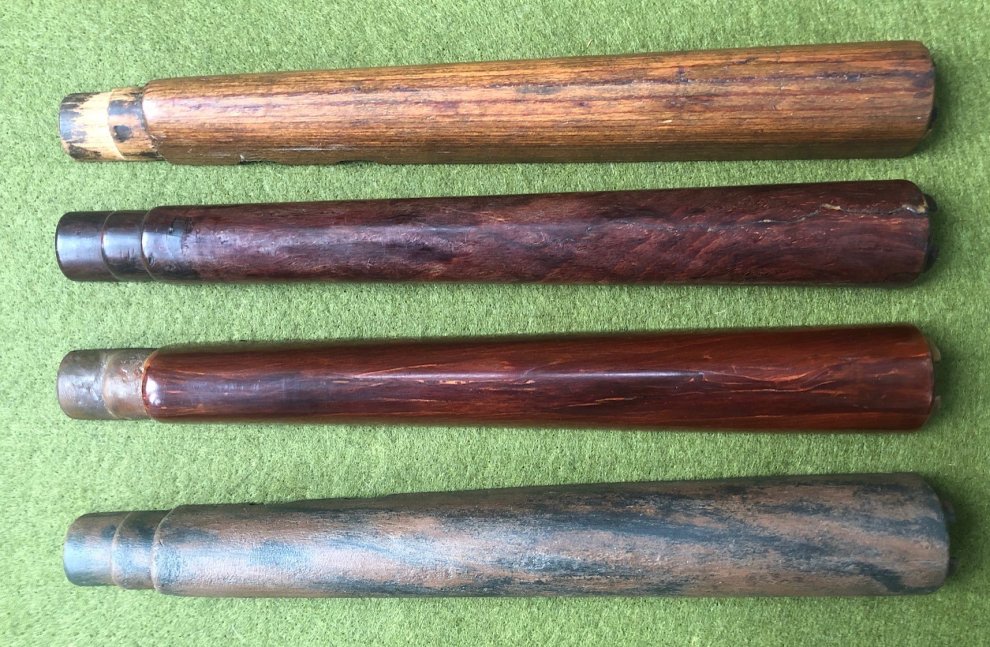 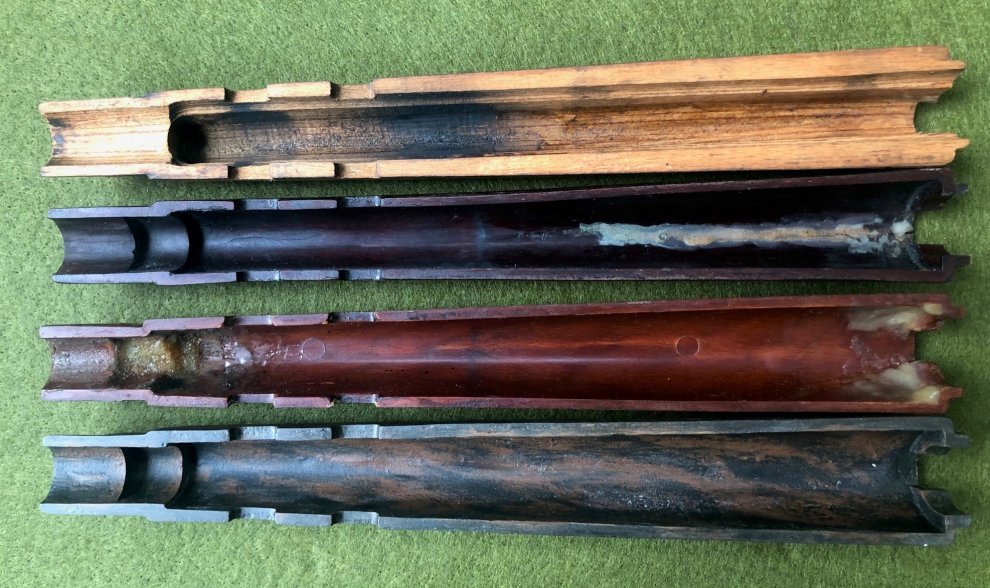 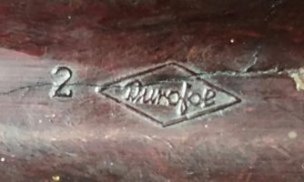
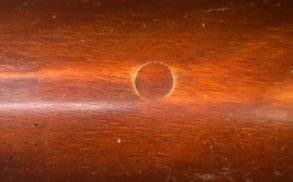
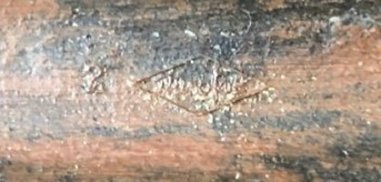 Org. Durofol, Synthetic VOPO, Repro Durofol The stock Two types of stocks were used. An uncommon type - a wide stock with a flat lower surface, here with a strange logo and the normal type on the right side of the photo. Note that Walther from about their 45 "a" serial number block moved the cross lug 18 mm forward. 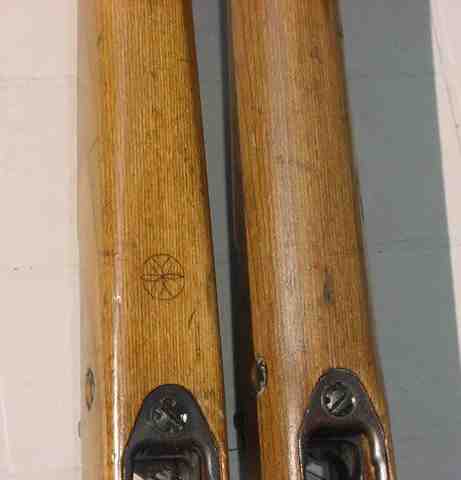
|

